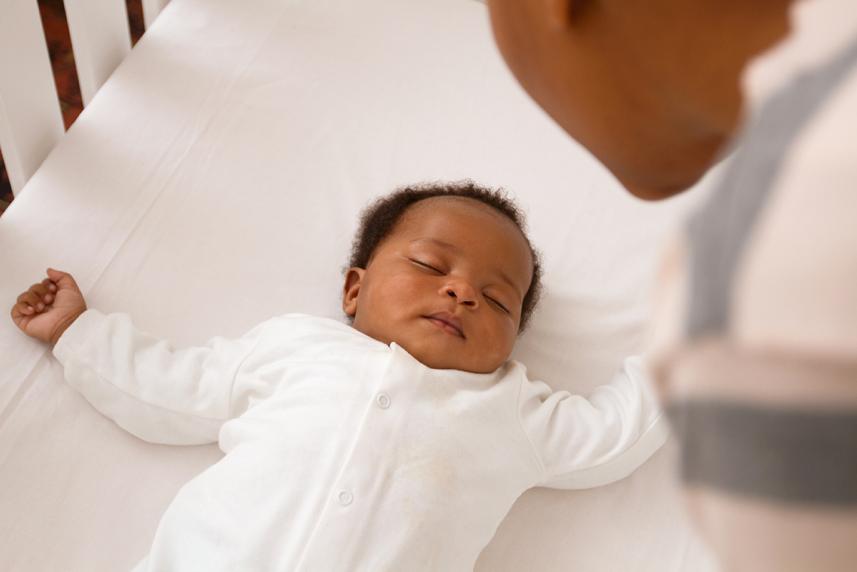Ways to help your baby fall asleep (and stay asleep)
Expert tips to help your baby—and you—get some quality shut-eye

Sleep is a frequent topic of discussion when it comes to babies. After all, they’re likely waking up and crying for your attention every few hours—and you’re probably exhausted.
Rest assured: This type of sleep pattern is all normal.
“Newborns spend most of their time sleeping—about 18 hours within a 24-hour period,” says Joanna Parga-Belinkie, M.D., assistant and clinical neonatologist at the Children’s Hospital of Philadelphia. However, they’re usually not asleep for longer than a few hours at a stretch.
In fact, Dr. Parga-Belinkie says, “they shouldn’t sleep for more than three to four hours at a time, because they need to stay hydrated and receive proper nutrients.” Since their stomachs are small and they grow quickly in the early weeks and months of their lives, they need to be fed around the clock, says a UNICEF resource. What’s more, in the first week, babies tend to lose weight, Dr. Parga-Belinkie says, so they may need to eat more often.
She notes that every baby is different—but they usually feed every hour and a half to every three hours, so she advises that you don’t let four hours go by without a feeding.
Dr. Parga-Belinkie also suggests talking to your pediatrician about creating an appropriate feeding schedule. “Pediatricians like to see babies one to two days after hospital discharge,” she says. “They’ll then decide the frequency of visits based on weight gain and other things.”
But at what point should my baby be expected to sleep through the whole night?
“There are no ‘shoulds’ with sleep and babies,” says Dr. Parga-Belinkie, adding that there’s not a certain age where, if your baby isn’t sleeping through the night (typically six to eight hours), you should be alarmed.
In fact, a 2018 Pediatrics study found that between 27.9 and 57 percent of six- and 12-month-old babies don’t sleep through the night. So, as Dr. Parga-Belinkie stresses, “if your baby is otherwise hitting milestones and growing well, you shouldn’t worry.”
However, when they’re around six months old, she says you can start trying some sleep training techniques. Around that same time is when babies can start to have regular sleep cycles, says the American Academy of Pediatrics.
1. Establish (and maintain) a bedtime routine
“One of the most important things is a bedtime routine,” says Dr. Parga-Belinkie, noting that it helps to calm the baby down and gets them used to knowing that it’s time to go to sleep. The National Sleep Foundation adds that babies who have a consistent bedtime routine sleep better and cry less.
This routine can last anywhere between 10 to 30 minutes, Dr. Parga-Belinkie says—but again, there are no “shoulds.” She stresses that there’s little evidence and research about how long it can or should last. But, as the mother of a young baby herself, she says she takes 30 minutes with her daughter.
The specifics of the routine can vary from family to family. However, it can include things like bath time and a calming exercise (like massaging or reading books).
Feeding can also be part of the bedtime routine, but Dr. Parga-Belinkie cautions that it should not be your last step. You don’t want the baby to associate falling asleep with food, because then they could want you to feed them every time they wake up—even if it’s the middle of the night.
And avoid electronics. Screen time should be limited for infants and small children, Dr. Parga-Belinkie says, and it can be overstimulating, which is not something you want at bedtime.
2. Dim the lights, then darken completely
Dr. Parga-Belinkie notes that a dimly lit room can help to establish circadian rhythms for babies, which is an internal process that helps set the sleep/wake cycle.
“What I generally do is dim the room lights (we have our ceiling lights on a dimmer) and put on string lights that we have as decoration across the ceiling at bedtime,” Dr. Parga-Belinkie explains.
And then “when the baby tries to sleep, the room should be dark”—she notes that using blackout curtains may be helpful, especially in the summer months when the baby may be going to sleep when it’s still light outside. However, you can leave a nightlight on. Dr. Parga-Belinkie uses one in her daughter’s room and says that it’s useful for when you have to go soothe your crying child, so you’re not feeling around blindly.
3. Keep the room at a comfortable temperature
“Babies are more at risk for heat loss and for being overheated,” Dr. Parga-Belinkie says. Overheating, in particular, is something to watch out for, says Nemours (a nonprofit children’s health system). They suggest making sure your baby isn’t sweating and doesn’t feel hot to the touch.
Setting the temperature in the room to 70 degrees Fahrenheit should work, but use your discretion—Dr. Parga-Belinkie reasons that if you’re a little cold, your baby probably is, too.
4. Try white noise
Dr. Parga-Belinkie recommends using white noise, “which is anything that drowns out background noise in a room and helps to calm.” She notes that the lack of complexity and monotone sound makes it a solid solution for getting a baby to fall, and stay, asleep.
There’s also scientific data touting the benefits of white noise as a sleep aid for young ones: A 2019 study found that white noise helps babies both fall asleep faster and wake up less frequently during the night.
“Examples are rhythmic whooshing sounds meant to mimic blood flow around the uterus, heart tones [or heart sounds], ocean waves, and rain sounds,” she says. “A fan is also a good option. There’s no research on the ‘best,’ so it’s a bit of trial and error.”
While Dr. Parga-Belinkie says it’s fine to use a Spotify or YouTube playlist for white noise, it might be helpful to use something other than your phone. She recommends buying a sound machine that has a dedicated white noise function, so you can use fewer electronics around your baby, and you don’t have to worry about your phone being tied up as a sleep device for them.
5. Don’t rock your baby completely to sleep
As you’re rocking your baby to sleep, notice when they start to get sleepy. Their eyelids will look like they’re getting heavy, and their eyes will close for at least a few seconds. When that happens, put them in their crib—before they actually fall asleep—and let them fall completely asleep by themselves.
The point is to help your baby learn how to self-soothe and fall back asleep on their own when they wake up in the middle of the night. That way, they won’t have to rely on you rocking and holding them to fall back asleep—and, hopefully, that’ll mean you can get some more Zzzs.
The bottom line
“Having a newborn means you’re not going to have a normal sleep schedule,” says Dr. Parga-Belinkie. “The baby’s not going to be sleeping through the night in the beginning, and you will be sleep-deprived, but again, that’s all normal.”
And keep in mind that the sleep training may not work right away. “It can take many months for a baby to develop a more stable sleep schedule and be able to be trained to sleep,” says Dr. Parga-Belinkie.
But remember that it’s a training that will take time and give each technique a few days, she says. The key is to be patient and make sure you get help if you need it.



